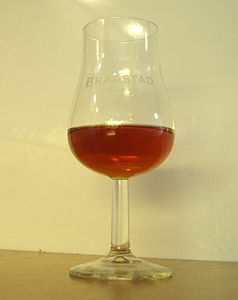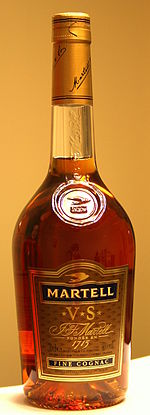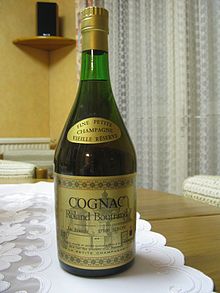- Cognac (brandy)
-
Cognac Type Brandy Manufacturer Various, including Courvoisier, Hennessy, Martell, Rémy Martin Country of origin
 France
FranceAlcohol by volume
40%Flavour Varies, though typically with characteristics combining nuts, fruit, caramel, honey, vanilla, and/or other spices[1] Variants VS, VSOP, XO Related products
Armagnac, VinjakWebsite Bureau National Interprofessionnel du Cognac (English) Cognac (
 /ˈkɒnjæk/ kon-yak), named after the town of Cognac in France, is a variety of brandy. It is produced in the wine-growing region surrounding the town from which it takes its name, in the French Departements of Charente and Charente-Maritime.
/ˈkɒnjæk/ kon-yak), named after the town of Cognac in France, is a variety of brandy. It is produced in the wine-growing region surrounding the town from which it takes its name, in the French Departements of Charente and Charente-Maritime.As an Appellation d'origine contrôlée, in order to bear the name Cognac, the production methods for the distilled brandy must meet specified legal requirements. It must be made from certain grapes (see below); of these, Ugni Blanc, known locally as Saint-Emilion, is the most widely used variety today.[citation needed] It must be distilled twice in copper pot stills and aged at least two years in French oak barrels from Limousin or Tronçais. Most cognacs are aged considerably longer than the minimum legal requirement, because cognac matures in the same way as whiskies and wine when aged in a barrel.
Contents
Producing region and legal definitions
The region authorised to produce cognac is divided into six zones, including five crus broadly covering the department of Charente-Maritime, a large part of the department of Charente and a few areas in Deux-Sèvres and the Dordogne. The six zones are: Grande Champagne, Petite Champagne, Borderies, Fins Bois, Bon Bois and finally Bois Ordinaire. A blend of Grande and Petite Champagne Cognacs, with at least half coming from Grande Champagne, is known as Fine Champagne.
Cognac-producing regions should not be confused with the northeastern region of Champagne, a wine region that produces sparkling wine by that name, although they do share a common etymology – both being derivations of a French term for chalky soil.
Production process
Cognac is made from fruit brandy, called eau de vie in English,[2] produced by doubly distilling the white wines produced in any of the growth areas.
Grapes
The wine is very dry, acidic, and thin, "virtually undrinkable",[3] but excellent for distillation and aging. It may be made only from a strict list of grape varieties, if it is to carry the name of one of the crus then it must be at least 90% Ugni Blanc (known in Italy as Trebbiano), Folle Blanche and Colombard, although 10% of the grapes used can be Folignan, Jurançon blanc, Meslier St-François (also called Blanc Ramé), Sélect, Montils or Sémillon.[4][5] Cognacs which are not to carry the name of a cru are freer in the allowed grape varieties, needing at least 90% Colombard, Folle Blanche, Jurançon blanc, Meslier Saint-François, Montils, Sémillon, or Ugni Blanc, and up to 10% Folignan or Sélect.
Fermentation and distillation
A cognac pot still.
After the grapes are pressed, the juice is left to ferment for two or three weeks, with the region's native, wild yeasts converting the sugar into alcohol; neither sugar nor sulfur may be added.[6] At this point, the resulting wine is about 7 to 8% alcohol.[6]
Distillation takes place in traditionally shaped Charentais copper stills, also known as an alembic, the design and dimensions of which are also legally controlled. Two distillations must be carried out; the resulting eau-de-vie is a colourless spirit of about 70% alcohol.[3]
Aging
Once distillation is complete, it must be aged in oak for at least two years before it can be sold to the public. As the cognac interacts with the oak barrel and the air, it evaporates at the rate of about three percent each year, slowly losing both alcohol and water[3] Because the alcohol dissipates faster than the water, cognac reaches the target 40% alcohol by volume in about four or five years, though lesser grades can be produced much sooner by diluting the cognac with water, which also makes its flavor less concentrated.[3] Since oak barrels stop contributing to flavor after four or five decades, cognac is then transferred to large glass carboys called bonbonnes, then stored for future blending.[3]
Blending
The age of the cognac is calculated as that of the youngest eau-de-vie used in the blend. The blend is usually of different ages and (in the case of the larger and more commercial producers) from different local areas. This blending, or marriage, of different eaux-de-vie is important to obtain a complexity of flavours absent from an eau-de-vie from a single distillery or vineyard. Each cognac house has a master taster (maître de chai), who is responsible for creating this delicate blend of spirits, so that the cognac produced by a company today will taste almost exactly the same as a cognac produced by that same company 50 years ago, or in 50 years' time.[citation needed] In this respect it is similar to the process of blending whisky or non-vintage Champagne to achieve a consistent brand flavor. A very small number of producers, such as Guillon Painturaud and Moyet, do not blend their final product from different ages of eaux-de-vie to produce a 'purer' flavour (a practice roughly equivalent to the production of a single-cask Scotch whisky). [7] Hundreds of vineyards in the Cognac AOC region sell their own cognac. These are likewise blended from the eaux-de-vie of different years, but they are single-vineyard cognacs, varying slightly from year to year and according to the taste of the producer, hence lacking some of the predictability of the better-known commercial products. Depending on their success in marketing, small producers may sell a larger or smaller proportion of their product to individual buyers, wine dealers, bars and restaurants, the remainder being acquired by larger cognac houses for blending. The success of artisanal cognacs has encouraged some larger industrial-scale producers to produce single-vineyard cognacs.
Grades
According to the BNIC (Bureau National Interprofessionnel du Cognac), the official quality grades of cognac are the following:
- V.S. ("very special"),[8] Very Special, or ✯✯✯ (three stars) designates a blend in which the youngest brandy has been stored for at least two years in cask.
- V.S.O.P. ("very superior old pale")[9] designates a blend in which the youngest brandy is stored for at least four years in a cask, but the average wood age is much older.
- XO ("extra old") designates a blend in which the youngest brandy is stored for at least six years but on average for upwards of 20 years. On 1 April 2016, the minimum storage age of the youngest brandy used in an XO blend will be set to ten years.
The names of the grades are in English because the British market was long the primary market for cognac or, as explained in the FAQ of the BNIC website, because most of the main initial trading posts were created by people from Britain.
In addition the following can be mentioned:
- Napoleon is, according to the BNIC, a grade equal to XO in terms of minimum age, but it is generally marketed in-between VSOP and XO in the product range offered by the producers.
- Extra designates a minimum of 6 years of age, this grade is usually older than a Napoleon or an XO.
- Vieux is another grade between the official grades of VSOP and XO.
- Vieille Réserve is, like the Hors d´Âge, a grade beyond XO.
- Hors d'âge ("beyond age") is a designation which BNIC states is equal to XO, but in practice the term is used by producers to market a high quality product beyond the official age scale.
The crus where the grapes were grown can also be used to define the cognac, and give a guide to some of the flavour characteristics of the cognac:
- Grande Champagne (13,766 hectares (34,020 acres)) Grande Champagne eaux de vie are long in the mouth and powerful, dominated by floral notes. The most prestigious of the crus. "Champagne" derives from the Roman "Campania" meaning Plain, but is often explained with similarity in soil with the Champagne area at Rheims.
- Petite Champagne (16,171 hectares (39,960 acres)) Petite Champagne eaux de vie have similar characteristics to those from Grande Champagne but are in general shorter on the palate. Cognacs made from a mixture of Grande and Petite Champagne eaux de vie (with at least 50% Grande Champagne) may be marketed as Fine Champagne.
- Borderies (4,160 hectares (10,300 acres)) The smallest cru, eaux de vie from the Borderies are the most distinctive, with nutty aromas and flavour, as well as a distinct violet or iris characteristic. Cognacs made with a high percentage of these eaux de vie, for example, "Cordon Bleu" by Martell, are dominated by these very sought-after flavours.
- Fins Bois (34,265 hectares (84,670 acres)) Heavier and faster ageing eaux de vie ideal for establishing the base of some blended cognacs. Fins Bois is rounded and fruity, with an agreeable oiliness.
- Bons Bois
- Bois Ordinaires (19,979 hectares (49,370 acres) together with Bons Bois). Further out from the four central growth areas are the Bons Bois and the Bois Ordinaires grown regions. With a poorer soil and very much influenced by the maritime climate, this area of 20,000 hectares produces eaux de vie that are less demonstrative and age more quickly. These less prestigious crus are excluded from blends by some smaller boutique manufacturers and are generally used for high-volume production.
The growth areas are tightly defined; there exist pockets with soils atypical of the area producing eaux de vie that may have characteristics particular to their location. Hennessy usually uses the unofficial brandy grades for its cognac offerings, but has also produced three single distillery cognacs, each with very distinctive flavours arising from the different soils and, to a lesser extent, climate. Other cognac houses, such as Moyet, exclusively use the crus to describe their different cognacs.
Companies and brands
While there are close to 200 cognac producers,[1] a large percentage of cognac—90% according to one 2008 estimate[10]—is produced by only four companies: Courvoisier, Hennessy, Martell, and Rémy Martin.[3][10] Other brands include: Bache-Gabrielsen/Dupuy, Braastad, Camus, Chateau Fontpinot,[10] Delamain, Pierre Ferrand,[3] Frapin, Gaston de Casteljac, Hine,[10] Marcel Ragnaud,[3] Moyet, Otard and Cognac Croizet.
In popular culture
Since the early 1990s, cognac consumption has seen a significant transformation in its American consumer base from a predominantly older, affluent white demographic to younger, urban, and black consumers. Cognac has even become ingrained in hip hop culture, celebrated in songs.[10][11][12][12]
Pernod-Ricard, the parent company of Martell, has acknowledged that "the USA is the biggest market for cognac, and African-Americans are a priority target".[13] After poor sales in 1998 due to an economic crisis in Asia (cognac's main export market at the time) sales of cognac increased to approximately US $1 billion in America in 2003. This was a growth that coincided with hip-hop’s entry into the mainstream of American music.[citation needed]
Film
In the 1984 novel The Unbearable Lightness of Being and the 1988 film for which it was based, cognac is the drink of choice when the main characters, Tomas and Tereza, first meet, and is referenced additionally in the story when an under-aged patron requests some at Tereza's bar.[14]
In the 2006 German cold war film The Lives of Others, which won the 2007 Academy Award for Best Foreign Language Film, a glass of cognac is consumed by one of the lead characters during an integral scene of the plot.
Cognac-based drinks
- Grand Marnier: made from cognac and distilled essence of bitter orange
- Pineau des Charentes: a sweet aperitif, composed of eau-de-vie and grape must, made in the Charente region
References
- ^ a b Hacker, Richard Carleton (23 February 2006). "Elegance in a glass". San Francisco Chronicle. http://www.sfgate.com/cgi-bin/article.cgi?f=/c/a/2006/02/23/WIGMIHAKNA1.DTL&type=printable. Retrieved 1 December 2010.
- ^ In French, eau-de-vie means "brandy" (any brandy).
- ^ a b c d e f g h Lukacs, Paul. "How Good is Cognac?". Saveur (22). http://www.saveur.com/article/Wine-and-Drink/How-Good-is-Cognac. Retrieved 1 December 2010.
- ^ "Appellation of Origin". Bureau National Interprofessionel du Cognac. http://www.cognac.fr/cognac/_en/2_cognac/index.aspx?page=appellation.
- ^ "Harvesting and vinification". Bureau National Interprofessionel du Cognac. http://www.cognac.fr/cognac/_en/2_cognac/index.aspx?page=vendanges.
- ^ a b Koscica, Milica (April 2004). "TED Case Studies – Number 728". Trade Environment Database. American University, School of International Service. http://www1.american.edu/ted/cognac.htm. Retrieved 1 December 2010.
- ^ "Single Estate Cognac". 2009. http://www.singleestatecognac.com. Retrieved 21 July 2009.
- ^ As explained on the website of the BNIC and as shown on the labels of some manufacturers, the meaning of the abbreviation V.S. is "very special", but it is often erroneously explained as an abbreviation of "very superior" due to confusion with the meaning of V.S.O.P., which is "very superior old pale".
- ^ As explained on the website of the BNIC, the meaning of the abbreviation V.S.O.P is "very superior old pale", but it is often erroneously explained as an abbreviation of "very special old pale" (even in reputable sources such as the Oxford English Dictionary) due to confusion with the meaning of V.S., which is "very special".
- ^ a b c d e Steinberger, Mike (2 April 2008). "Cognac Attack!". Slate. http://www.slate.com/id/2188005/pagenum/all/. Retrieved 1 December 2010.
- ^ "Obama gets his own cognac: The Swamp". Swamppolitics.com. 15 January 2009. http://www.swamppolitics.com/news/politics/blog/2009/01/obama_gets_his_own_cognac.html. Retrieved 3 May 2009.
- ^ a b Lichfield, John (27 July 2003). "Cognac stages a comeback as rappers' drink of choice". The Independent (London). http://www.independent.co.uk/news/world/europe/cognac-stages-a-comeback-as-rappers-drink-of-choice-588152.html. Retrieved 3 May 2009.
- ^ Report by Pernod-Ricard
- ^ Kundera, Milan (2009 (reprint)). The Unbearable Lightness of Being (page 49). Harper Perennial. ISBN 0060932139.
Gallery
-
Old distillation limestone cooling table to produce Cognac (copper pipe at the bottom left), at La Chapelle-des-Pots
External links
- (English) The BNIC Cognac encyclopedia
- (English) Cognac official website Bureau National Interprofessionel du Cognac
Categories:- Cognac
- Brandies
- French distilled beverages
- Charente
- Charente-Maritime
Wikimedia Foundation. 2010.









